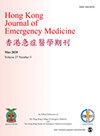Current situation and expectation of emergency medicine education for 8-year Doctor of Medicine degree program in China
IF 0.8
4区 医学
Q4 EMERGENCY MEDICINE
引用次数: 0
Abstract
Background: Appropriate lessons and formalized training concerning emergency medicine is becoming increasingly important in undergraduate medical education. There is an urgent need to evaluate undergraduate emergency medicine education of students enrolled on the 8-year Doctor of Medicine degree programs nationwide in China with the aim that the data extracted could ultimately be used to help develop a standardized emergency medicine curriculum in China. Objectives: The aim of the study is to accurately describe emergency medicine education of 8-year Doctor of Medicine program in China, including emergency medicine classes, clinical practice in emergency medicine department, and expectations toward emergency medicine education. Methods: An online questionnaire was distributed to all the medical students of 8-year Doctor of Medicine program who have attended emergency medicine education in 14 medical schools in China. Participation in the survey was voluntary and anonymized. Results: In total, 529 valid responses were collected. There was a clear difference between students with a career aspiration in emergency medicine and those without. Comparing to countries that have an established emergency medicine curriculum, shortage of classroom hours and clinical practice time is a major cause of unsatisfactory educational outcomes in China. A detailed uniform emergency medicine curriculum that outlines exact requirements for medical students is required as well. Conclusion: A consolidated syllabus and curriculum should be compiled by all the medical schools with the 8-year integrated Doctor of Medicine degree program in China. The specific diseases and skills that should be covered in emergency medical education remain up to debate.中国8年制医学博士急诊医学教育现状与展望
背景:适当的急救医学课程和正规的培训在本科医学教育中越来越重要。迫切需要评估中国全国8年制医学博士学位课程学生的本科急诊医学教育,以期提取的数据最终能够用于帮助制定中国标准化的急诊医学课程。目的:本研究旨在准确描述中国8年制医学博士项目的急诊医学教育,包括急诊医学课程、急诊科临床实践以及对急诊医学教育的期望。方法:采用网上问卷调查的方法,对全国14所医学院参加过急诊医学教育的8年制医学博士生进行问卷调查。参与调查是自愿和匿名的。结果:共收集到529份有效回复。有急诊医学职业抱负的学生和没有急诊医学职业志向的学生之间存在明显差异。与已有急诊医学课程的国家相比,课堂时间和临床实践时间的短缺是中国教育效果不理想的主要原因。此外,还需要一份详细的统一急诊医学课程,概述对医学生的确切要求。结论:我国所有具有8年制综合医学博士学位课程的医学院都应编制统一的教学大纲和课程。急诊医学教育应涵盖的具体疾病和技能仍有待讨论。
本文章由计算机程序翻译,如有差异,请以英文原文为准。
求助全文
约1分钟内获得全文
求助全文
来源期刊

Hong Kong Journal of Emergency Medicine
EMERGENCY MEDICINE-
CiteScore
1.50
自引率
16.70%
发文量
26
审稿时长
6-12 weeks
期刊介绍:
The Hong Kong Journal of Emergency Medicine is a peer-reviewed, open access journal which focusses on all aspects of clinical practice and emergency medicine research in the hospital and pre-hospital setting.
 求助内容:
求助内容: 应助结果提醒方式:
应助结果提醒方式:


